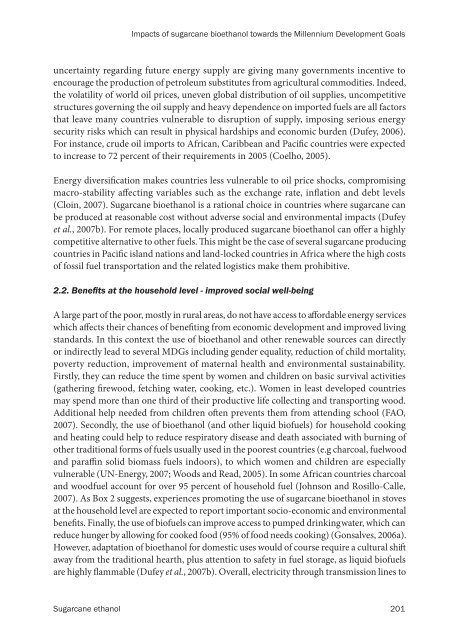Sugarcane ethanol: Contributions to climate change - BAFF
Sugarcane ethanol: Contributions to climate change - BAFF
Sugarcane ethanol: Contributions to climate change - BAFF
Create successful ePaper yourself
Turn your PDF publications into a flip-book with our unique Google optimized e-Paper software.
Impacts of sugarcane bio<strong>ethanol</strong> <strong>to</strong>wards the Millennium Development Goals<br />
uncertainty regarding future energy supply are giving many governments incentive <strong>to</strong><br />
encourage the production of petroleum substitutes from agricultural commodities. Indeed,<br />
the volatility of world oil prices, uneven global distribution of oil supplies, uncompetitive<br />
structures governing the oil supply and heavy dependence on imported fuels are all fac<strong>to</strong>rs<br />
that leave many countries vulnerable <strong>to</strong> disruption of supply, imposing serious energy<br />
security risks which can result in physical hardships and economic burden (Dufey, 2006).<br />
For instance, crude oil imports <strong>to</strong> African, Caribbean and Paci�c countries were expected<br />
<strong>to</strong> increase <strong>to</strong> 72 percent of their requirements in 2005 (Coelho, 2005).<br />
Energy diversi�cation makes countries less vulnerable <strong>to</strong> oil price shocks, compromising<br />
macro-stability a�ecting variables such as the ex<strong>change</strong> rate, in�ation and debt levels<br />
(Cloin, 2007). <strong>Sugarcane</strong> bio<strong>ethanol</strong> is a rational choice in countries where sugarcane can<br />
be produced at reasonable cost without adverse social and environmental impacts (Dufey<br />
et al., 2007b). For remote places, locally produced sugarcane bio<strong>ethanol</strong> can o�er a highly<br />
competitive alternative <strong>to</strong> other fuels. �is might be the case of several sugarcane producing<br />
countries in Paci�c island nations and land-locked countries in Africa where the high costs<br />
of fossil fuel transportation and the related logistics make them prohibitive.<br />
2.2. Benefits at the household level - improved social well-being<br />
A large part of the poor, mostly in rural areas, do not have access <strong>to</strong> a�ordable energy services<br />
which a�ects their chances of bene�ting from economic development and improved living<br />
standards. In this context the use of bio<strong>ethanol</strong> and other renewable sources can directly<br />
or indirectly lead <strong>to</strong> several MDGs including gender equality, reduction of child mortality,<br />
poverty reduction, improvement of maternal health and environmental sustainability.<br />
Firstly, they can reduce the time spent by women and children on basic survival activities<br />
(gathering �rewood, fetching water, cooking, etc.). Women in least developed countries<br />
may spend more than one third of their productive life collecting and transporting wood.<br />
Additional help needed from children o�en prevents them from attending school (FAO,<br />
2007). Secondly, the use of bio<strong>ethanol</strong> (and other liquid biofuels) for household cooking<br />
and heating could help <strong>to</strong> reduce respira<strong>to</strong>ry disease and death associated with burning of<br />
other traditional forms of fuels usually used in the poorest countries (e.g charcoal, fuelwood<br />
and para�n solid biomass fuels indoors), <strong>to</strong> which women and children are especially<br />
vulnerable (UN-Energy, 2007; Woods and Read, 2005). In some African countries charcoal<br />
and woodfuel account for over 95 percent of household fuel (Johnson and Rosillo-Calle,<br />
2007). As Box 2 suggests, experiences promoting the use of sugarcane bio<strong>ethanol</strong> in s<strong>to</strong>ves<br />
at the household level are expected <strong>to</strong> report important socio-economic and environmental<br />
bene�ts. Finally, the use of biofuels can improve access <strong>to</strong> pumped drinking water, which can<br />
reduce hunger by allowing for cooked food (95% of food needs cooking) (Gonsalves, 2006a).<br />
However, adaptation of bio<strong>ethanol</strong> for domestic uses would of course require a cultural shi�<br />
away from the traditional hearth, plus attention <strong>to</strong> safety in fuel s<strong>to</strong>rage, as liquid biofuels<br />
are highly �ammable (Dufey et al., 2007b). Overall, electricity through transmission lines <strong>to</strong><br />
<strong>Sugarcane</strong> <strong>ethanol</strong> 201












